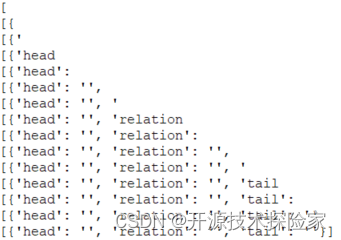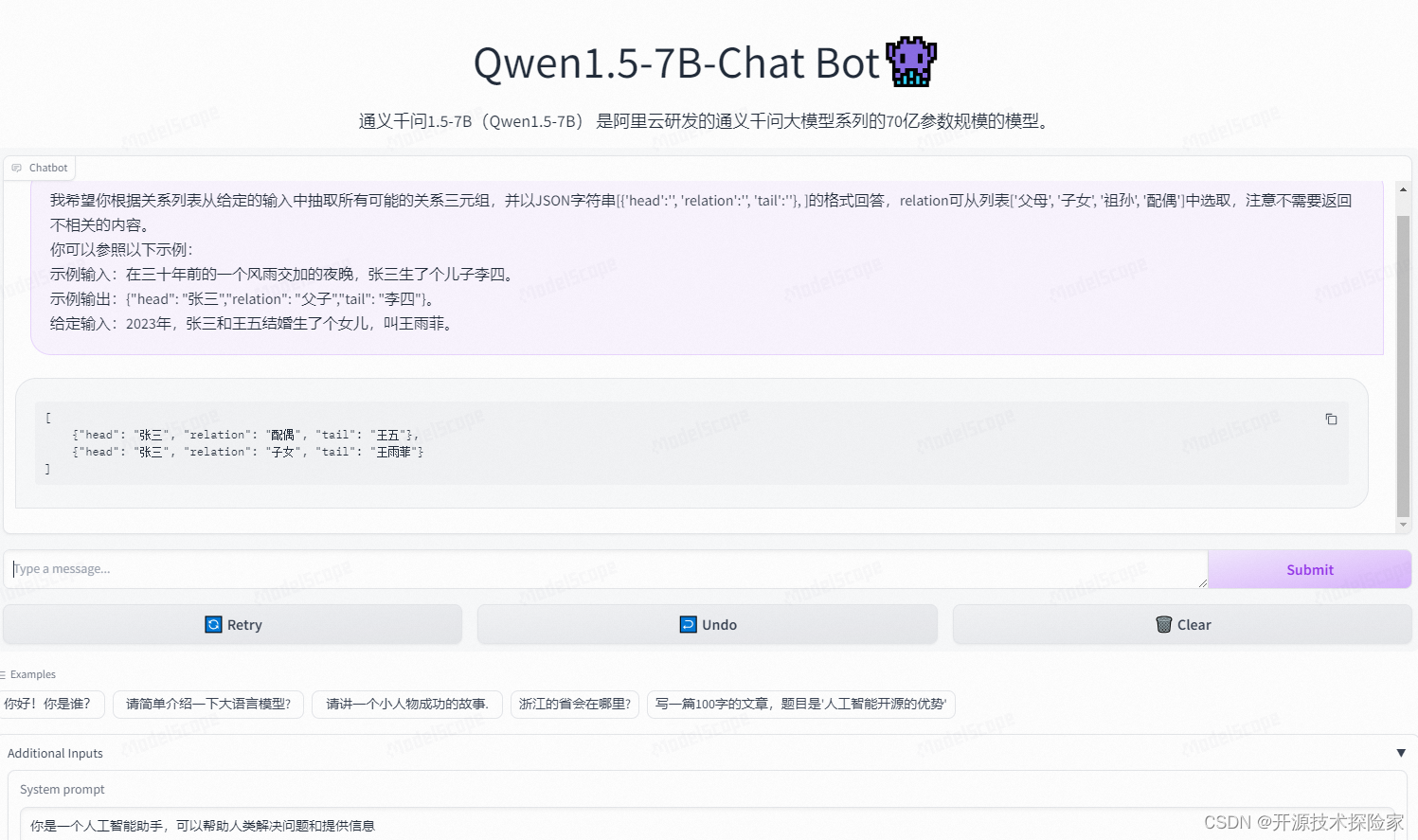一、前言
Zero-Shot、One-Shot和Few-Shot是机器学习领域中重要的概念,特别是在自然语言处理和计算机视觉领域。通过Zero-Shot、One-Shot和Few-Shot学习,模型可以更好地处理未知的情况和新任务,减少对大量标注数据的依赖,提高模型的适应性和灵活性。这对于推动人工智能在现实世界中的应用具有重要意义,尤其是在面对数据稀缺、标注成本高昂或需要快速适应新环境的场景下。
二、术语
2.1. Zero-shot
在零样本学习中,模型可以从未见过的类别中进行推理或分类。这意味着模型可以使用在其他类别上学到的知识来推广到新的类别,而无需在新类别上进行训练。
2.2. One-shot
在单样本学习中,模型根据非常有限的样本进行学习。通常情况下,模型只能从每个类别中获得一个样本,并且需要从这个样本中学习如何进行分类。
2.3. Few-shot
在少样本学习中,模型可以通过很少的样本进行学习,并且能够推广到新的类别。虽然少样本学习的定义没有具体的样本数量限制,但通常指的是模型只能从每个类别中获得很少的样本(例如,几个或几十个)。
三、前置条件
3.1. windows or linux操作系统均可
3.2. 下载chatglm3-6b模型
从huggingface下载:https://huggingface.co/THUDM/chatglm3-6b/tree/main

从魔搭下载:魔搭社区汇聚各领域最先进的机器学习模型,提供模型探索体验、推理、训练、部署和应用的一站式服务。https://www.modelscope.cn/models/ZhipuAI/chatglm3-6b/fileshttps://www.modelscope.cn/models/ZhipuAI/chatglm3-6b/files
3.3. 创建虚拟环境&安装依赖
conda create --name chatglm3 python=3.10
conda activate chatglm3
pip install protobuf transformers==4.30.2 cpm_kernels torch>=2.0 sentencepiece accelerate四、技术实现
4.1.Zero-Shot
# -*- coding = utf-8 -*-
from transformers import AutoTokenizer, AutoModelForCausalLM
import time
import tracebackmodelPath = "/model/chatglm3-6b"def chat(model, tokenizer, message, history, system):messages = []if system is not None:messages.append({"role": "system", "content": system})if history is not None:for his in history:user,assistant = hismessages.append({"role": "user", "content": user})messages.append({"role": "assistant", 'metadata': '', "content": assistant})try:for response in model.stream_chat(tokenizer,message, messages, max_length=2048, top_p=0.9, temperature=0.45, repetition_penalty=1.1,do_sample=True):_answer,_history = responseyield _answerexcept Exception:traceback.print_exc()def loadTokenizer():tokenizer = AutoTokenizer.from_pretrained(modelPath, use_fast=False, trust_remote_code=True)return tokenizerdef loadModel():model = AutoModelForCausalLM.from_pretrained(modelPath, device_map="auto", trust_remote_code=True).cuda()model = model.eval()# print(model)return modelif __name__ == '__main__':model = loadModel()tokenizer = loadTokenizer()start_time = time.time()message = '''
我希望你根据关系列表从给定的输入中抽取所有可能的关系三元组,并以JSON字符串[{'head':'', 'relation':'', 'tail':''}, ]的格式回答,relation可从列表['父母', '子女', '祖孙', '配偶']中选取,注意不需要返回不相关的内容。
给定输入:2023年,张三和王五结婚生了个女儿,叫王雨菲'''system = '你是一个人工智能助手,很擅长帮助人类回答问题'history = Noneresponse = chat(model, tokenizer, message,history,system)for answer in response:print(answer)end_time = time.time()print("执行耗时: {:.2f}秒".format(end_time - start_time))
调用结果:

4.2.One-Shot
# -*- coding = utf-8 -*-
from transformers import AutoTokenizer, AutoModelForCausalLM
import time
import tracebackmodelPath = "/model/chatglm3-6b"def chat(model, tokenizer, message, history, system):messages = []if system is not None:messages.append({"role": "system", "content": system})if history is not None:for his in history:user,assistant = hismessages.append({"role": "user", "content": user})messages.append({"role": "assistant", 'metadata': '', "content": assistant})try:for response in model.stream_chat(tokenizer,message, messages, max_length=2048, top_p=0.9, temperature=0.45, repetition_penalty=1.1,do_sample=True):_answer,_history = responseyield _answerexcept Exception:traceback.print_exc()def loadTokenizer():tokenizer = AutoTokenizer.from_pretrained(modelPath, use_fast=False, trust_remote_code=True)return tokenizerdef loadModel():model = AutoModelForCausalLM.from_pretrained(modelPath, device_map="auto", trust_remote_code=True).cuda()model = model.eval()# print(model)return modelif __name__ == '__main__':model = loadModel()tokenizer = loadTokenizer()start_time = time.time()message = '''
我希望你根据关系列表从给定的输入中抽取所有可能的关系三元组,并以JSON字符串[{'head':'', 'relation':'', 'tail':''}, ]的格式回答,relation可从列表['父母', '子女', '祖孙', '配偶']中选取,注意不需要返回不相关的内容。
你可以参照以下示例:示例输入:在三十年前的一个风雨交加的夜晚,张三生了个儿子李四。示例输出:{"head": "张三","relation": "父子","tail": "李四"}。
给定输入:2023年,张三和王五结婚生了个女儿,叫王雨菲'''system = '你是一个人工智能助手,很擅长帮助人类回答问题'history = Noneresponse = chat(model, tokenizer, message,history,system)for answer in response:print(answer)end_time = time.time()print("执行耗时: {:.2f}秒".format(end_time - start_time))
调用结果:

4.3.Few-Shot
# -*- coding = utf-8 -*-
from transformers import AutoTokenizer, AutoModelForCausalLM
import time
import tracebackmodelPath = "/model/chatglm3-6b"def chat(model, tokenizer, message, history, system):messages = []if system is not None:messages.append({"role": "system", "content": system})if history is not None:for his in history:user,assistant = hismessages.append({"role": "user", "content": user})messages.append({"role": "assistant", 'metadata': '', "content": assistant})try:for response in model.stream_chat(tokenizer,message, messages, max_length=2048, top_p=0.9, temperature=0.45, repetition_penalty=1.1,do_sample=True):_answer,_history = responseyield _answerexcept Exception:traceback.print_exc()def loadTokenizer():tokenizer = AutoTokenizer.from_pretrained(modelPath, use_fast=False, trust_remote_code=True)return tokenizerdef loadModel():model = AutoModelForCausalLM.from_pretrained(modelPath, device_map="auto", trust_remote_code=True).cuda()model = model.eval()# print(model)return modelif __name__ == '__main__':model = loadModel()tokenizer = loadTokenizer()start_time = time.time()message = '''
我希望你根据关系列表从给定的输入中抽取所有可能的关系三元组,并以JSON字符串[{'head':'', 'relation':'', 'tail':''}, ]的格式回答,relation可从列表['父母', '子女', '祖孙', '配偶']中选取,注意不需要返回不相关的内容。
你可以参照以下示例:示例输入1:在三十年前的一个风雨交加的夜晚,张三生了个儿子李四。示例输出1:{"head": "张三","relation": "父子","tail": "李四"}。示例输入2:小明和小李上个月结婚了。示例输出2:{"head": "小明","relation": "配偶","tail": "小李"}。
给定输入:2023年,张三和王五结婚生了个女儿,叫王雨菲'''system = '你是一个人工智能助手,很擅长帮助人类回答问题'history = Noneresponse = chat(model, tokenizer, message,history,system)for answer in response:print(answer)end_time = time.time()print("执行耗时: {:.2f}秒".format(end_time - start_time))

五、附带说明
5.1.测试结果
ChatGLM3-6B模型规模相对较小,在关系抽取测试任务中表现一般,在同样的模型参数和测试数据下,QWen1.5-7B-Chat的表现会更加优异,在Zero-Shot场景下,也有较好的表现。具体测试情况如下:
Zero-Shot:基本能识别出关系三元组,同时返回较多无效内容

One-Shot:能准确识别出关系三元组,且无返回无效内容

Few-Shot:能准确识别出关系三元组,且无返回无效内容



















)
